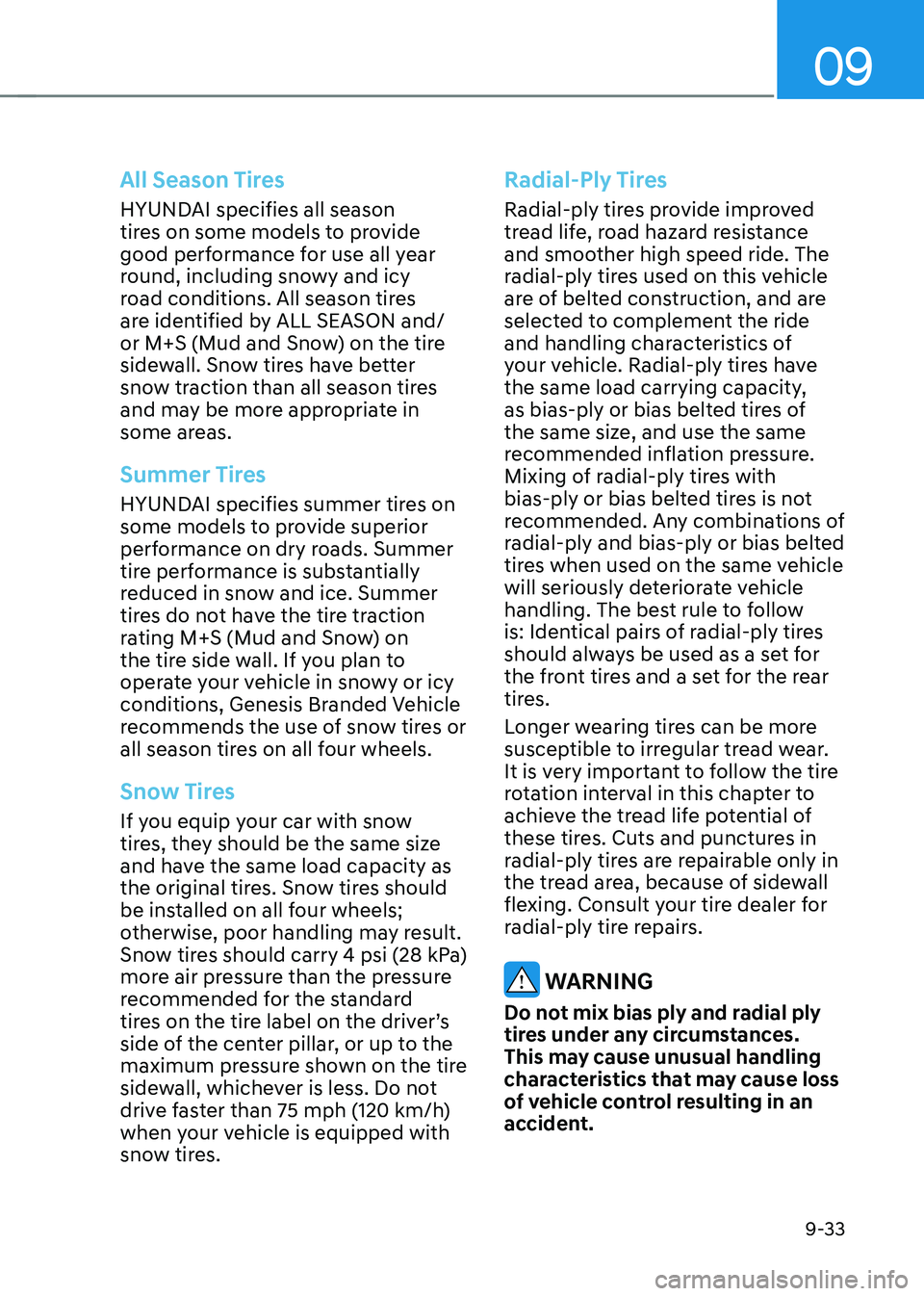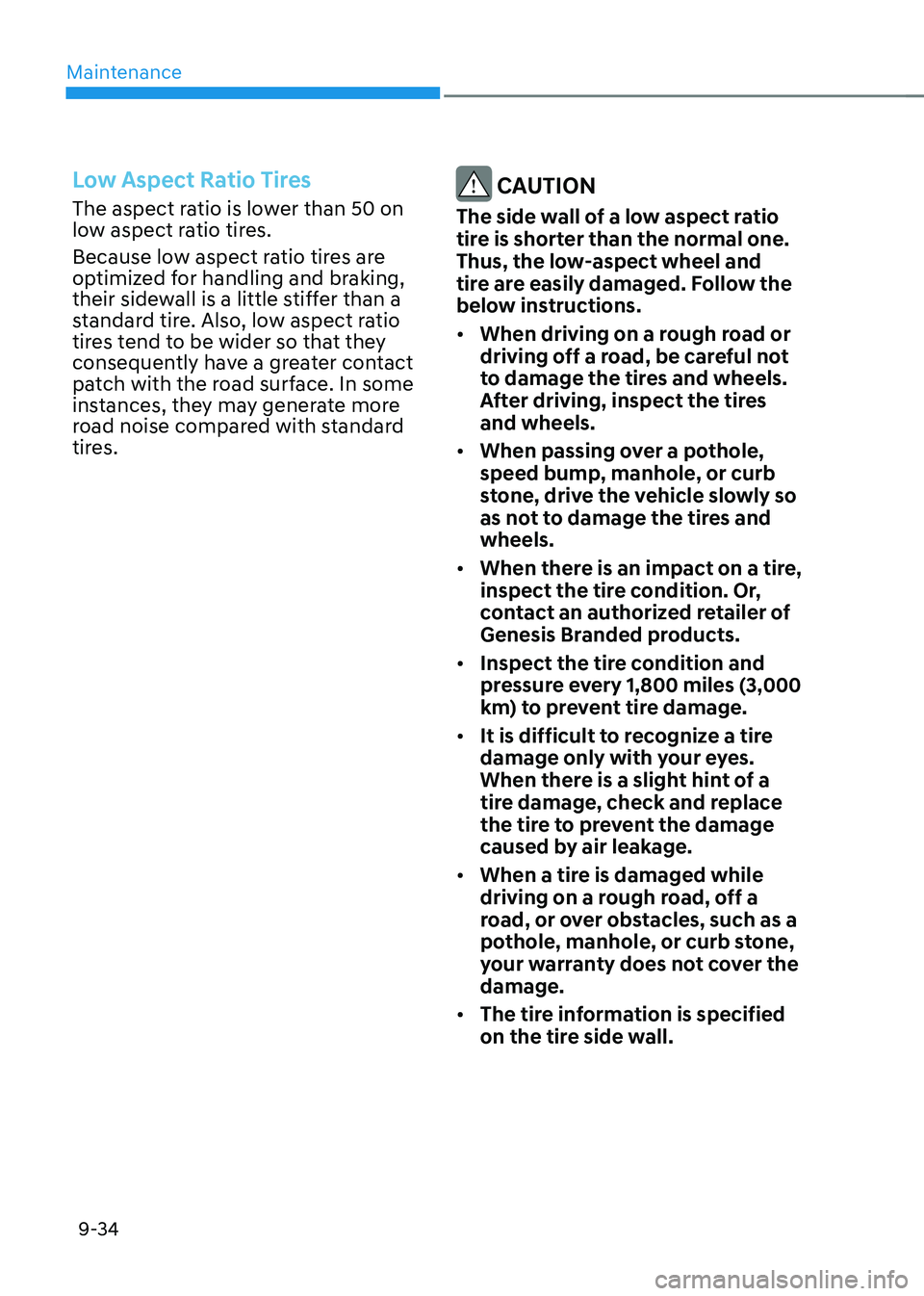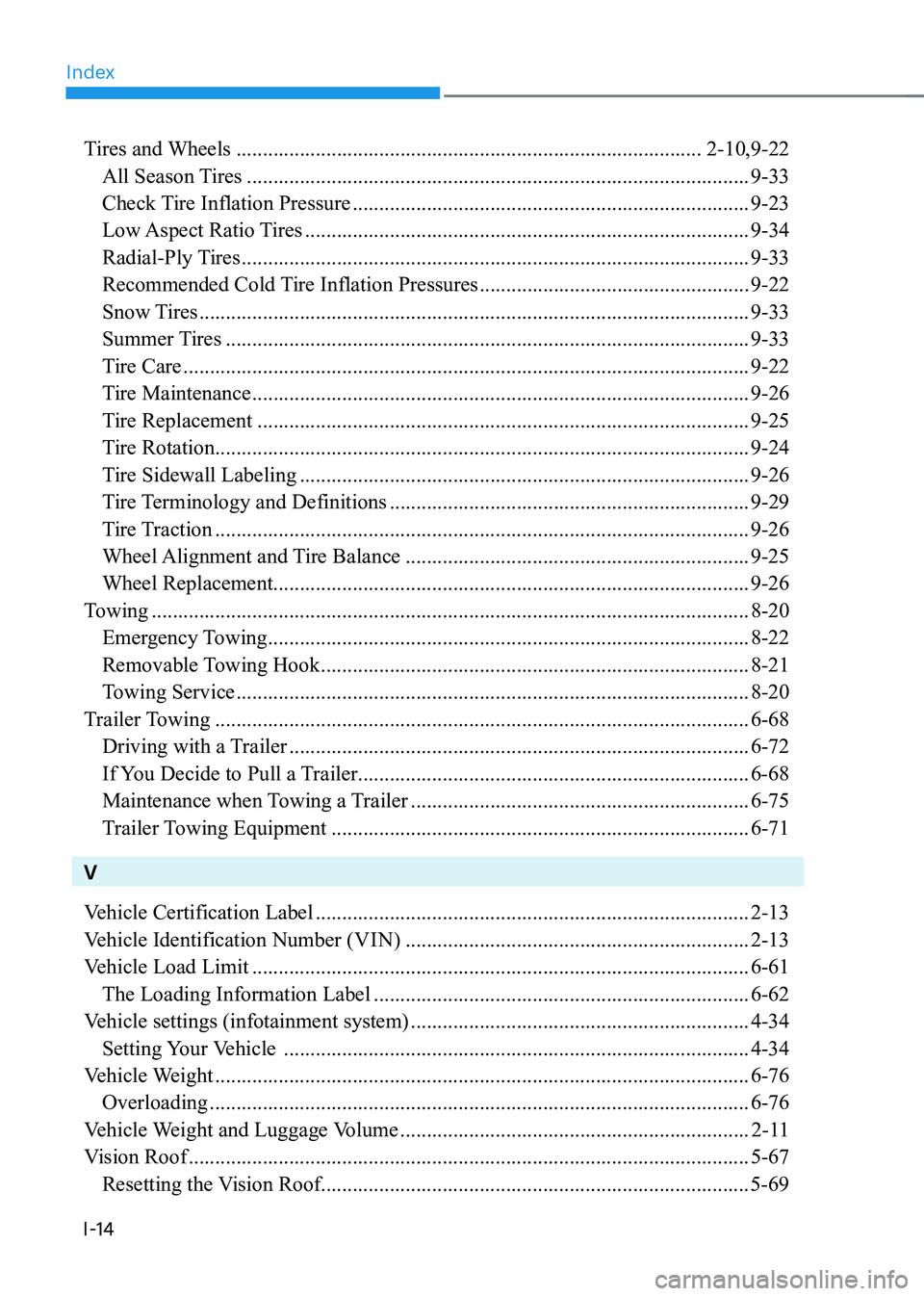2023 HYUNDAI IONIQ 5 tires
[x] Cancel search: tiresPage 629 of 680

Maintenance
9-28
4. Tire ply composition and material
The number of layers or plies of
rubber-coated fabric in the tire. Tire
manufacturers also must indicate the
materials in the tire, which include steel,
nylon, polyester, and others. The letter
“R” means radial ply construction; the
letter “D“ means diagonal or bias ply
construction; and the letter “B” means
belted-bias ply construction.
5. Maximum permissible inflation
pressure
This number is the greatest amount
of air pressure that should be put in
the tire. Do not exceed the maximum
permissible inflation pressure. Refer to
the Tire and Loading Information label
for recommended inflation pressure.
6. Maximum load rating
This number indicates the maximum
load in kilograms and pounds that can be
carried by the tire. When replacing the
tires on the vehicle, always use a tire that
has the same load rating as the factory
installed tire.
7. Uniform tire quality grading
Quality grades can be found where
applicable on the tire sidewall between
tread shoulder and maximum section width.
For example:
TREADWEAR 200
TRACTION AA
TEMPERATURE A
Tread wear
The tread wear grade is a comparative
rating based on the wear rate of the tire
when tested under controlled conditions
on a specified government test course.
For example, a tire graded 150 would
wear one-and-a-half times (1½) as well
on the government course as a tire
graded 100.
The relative performance of tires depends upon the actual conditions
of their use, however, and may depart
significantly from the norm due to
variations in driving habits, service
practices and differences in road
characteristics and climate.
These grades are molded on the
sidewalls of passenger vehicle tires. The
tires available as standard or optional
equipment on your vehicle may vary with
respect to grade.
Traction - AA, A, B & C
The traction grades, from highest to
lowest, are AA, A, B and C. Those grades
represent the tire’s ability to stop on wet
pavement as measured under controlled
conditions on specified government
test surfaces of asphalt and concrete.
A tire marked C may have poor traction
performance.
WARNING
The traction grade assigned to this
tire is based on straight ahead braking
traction tests, and does not include
acceleration, cornering, hydroplaning,
or peak traction characteristics.
Page 634 of 680

09
9-33
All Season Tires
HYUNDAI specifies all season
tires on some models to provide
good performance for use all year
round, including snowy and icy
road conditions. All season tires
are identified by ALL SEASON and/
or M+S (Mud and Snow) on the tire
sidewall. Snow tires have better
snow traction than all season tires
and may be more appropriate in
some areas.
Summer Tires
HYUNDAI specifies summer tires on
some models to provide superior
performance on dry roads. Summer
tire performance is substantially
reduced in snow and ice. Summer
tires do not have the tire traction
rating M+S (Mud and Snow) on
the tire side wall. If you plan to
operate your vehicle in snowy or icy
conditions, Genesis Branded Vehicle
recommends the use of snow tires or
all season tires on all four wheels.
Snow Tires
If you equip your car with snow
tires, they should be the same size
and have the same load capacity as
the original tires. Snow tires should
be installed on all four wheels;
otherwise, poor handling may result.
Snow tires should carry 4 psi (28 kPa)
more air pressure than the pressure
recommended for the standard
tires on the tire label on the driver’s
side of the center pillar, or up to the
maximum pressure shown on the tire
sidewall, whichever is less. Do not
drive faster than 75 mph (120 km/h)
when your vehicle is equipped with
snow tires.
Radial-Ply Tires
Radial-ply tires provide improved
tread life, road hazard resistance
and smoother high speed ride. The
radial-ply tires used on this vehicle
are of belted construction, and are
selected to complement the ride
and handling characteristics of
your vehicle. Radial-ply tires have
the same load carrying capacity,
as bias-ply or bias belted tires of
the same size, and use the same
recommended inflation pressure.
Mixing of radial-ply tires with
bias-ply or bias belted tires is not
recommended. Any combinations of
radial-ply and bias-ply or bias belted
tires when used on the same vehicle
will seriously deteriorate vehicle
handling. The best rule to follow
is: Identical pairs of radial-ply tires
should always be used as a set for
the front tires and a set for the rear
tires.
Longer wearing tires can be more
susceptible to irregular tread wear.
It is very important to follow the tire
rotation interval in this chapter to
achieve the tread life potential of
these tires. Cuts and punctures in
radial-ply tires are repairable only in
the tread area, because of sidewall
flexing. Consult your tire dealer for
radial-ply tire repairs.
WARNING
Do not mix bias ply and radial ply
tires under any circumstances.
This may cause unusual handling
characteristics that may cause loss
of vehicle control resulting in an
accident.
Page 635 of 680

Maintenance
9-34
Low Aspect Ratio Tires
The aspect ratio is lower than 50 on
low aspect ratio tires.
Because low aspect ratio tires are
optimized for handling and braking,
their sidewall is a little stiffer than a
standard tire. Also, low aspect ratio
tires tend to be wider so that they
consequently have a greater contact
patch with the road surface. In some
instances, they may generate more
road noise compared with standard
tires.
CAUTION
The side wall of a low aspect ratio
tire is shorter than the normal one.
Thus, the low-aspect wheel and
tire are easily damaged. Follow the
below instructions. • When driving on a rough road or
driving off a road, be careful not
to damage the tires and wheels.
After driving, inspect the tires and wheels.
• When passing over a pothole, speed bump, manhole, or curb
stone, drive the vehicle slowly so
as not to damage the tires and wheels.
• When there is an impact on a tire,
inspect the tire condition. Or,
contact an authorized retailer of
Genesis Branded products.
• Inspect the tire condition and
pressure every 1,800 miles (3,000
km) to prevent tire damage.
• It is difficult to recognize a tire
damage only with your eyes.
When there is a slight hint of a
tire damage, check and replace
the tire to prevent the damage
caused by air leakage.
• When a tire is damaged while
driving on a rough road, off a
road, or over obstacles, such as a
pothole, manhole, or curb stone,
your warranty does not cover the damage.
• The tire information is specified
on the tire side wall.
Page 679 of 680

Index
I-14
Tires and Wheels ........................................................................................ 2-10,9-22
All Season Tires ............................................................................................... 9-33
Check Tire Inflation Pressure ........................................................................... 9-23
Low Aspect Ratio Tires .................................................................................... 9-34
Radial-Ply Tires ................................................................................................ 9-33
Recommended Cold Tire Inflation Pressures ...................................................9-22
Snow Tires ........................................................................................................ 9-33
Summer Tires ................................................................................................... 9-33
Tire Care ........................................................................................................... 9-22
Tire Maintenance .............................................................................................. 9-26
Tire Replacement ............................................................................................. 9-25
Tire Rotation ..................................................................................................... 9-24
Tire Sidewall Labeling ..................................................................................... 9-26
Tire Terminology and Definitions .................................................................... 9-29
Tire Traction ..................................................................................................... 9-26
Wheel Alignment and Tire Balance ................................................................. 9-25
Wheel Replacement .......................................................................................... 9-26
Towing ................................................................................................................. 8-20
Emergency Towing ........................................................................................... 8-22
Removable Towing Hook ................................................................................. 8-21
Towing Service ................................................................................................. 8-20
Trailer Towing ..................................................................................................... 6-68
Driving with a Trailer ....................................................................................... 6-72
If You Decide to Pull a Trailer.......................................................................... 6-68
Maintenance when Towing a Trailer ................................................................ 6-75
Trailer Towing Equipment ............................................................................... 6-71
V
Vehicle Certification Label .................................................................................. 2-13
Vehicle Identification Number ( VIN) ................................................................. 2-13
Vehicle Load Limit .............................................................................................. 6-61
The Loading Information Label ....................................................................... 6-62
Vehicle settings (infotainment system) ................................................................ 4-34
Setting Your Vehicle ........................................................................................ 4-34
Vehicle Weight ..................................................................................................... 6-76
Overloading ...................................................................................................... 6-76
Vehicle Weight and Luggage Volume .................................................................. 2-11
Vision Roof .......................................................................................................... 5-67
Resetting the Vision Roof................................................................................. 5-69